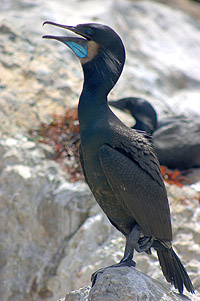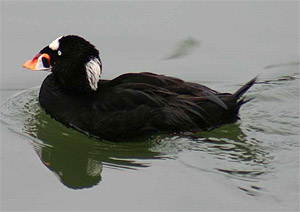
|
|||||||||||||||
|
| |||||||||||||||
Open-ocean birds begin to migrate to breeding colonies During March, much of the action in the open ocean takes place below the surface, where marine organisms such as diatoms and larval fish begin to proliferate. Of course, most of this activity is invisible to a person standing on the shore, or even a person in a boat at sea. In contrast, the migrations of sea birds and marine mammals are some of the most visible signs of spring. Many of these animals are easy to see, even for a casual, shore-bound observer (though a pair of binoculars makes the process much more enjoyable). March is a transition period for many birds and marine mammals, with some migrating away from the Central Coast to breed, while others arrive to feed on the bounty associated with upwelling and spring phytoplankton blooms. For example, a variety of sea birds, including ashy storm petrels, rhinoceros auklets, and common murres, leave Monterey Bay in March. They don't go far, however--just a hundred miles up the coast to the Farallon Islands, where they form huge nesting colonies during spring and summer. Some murres also head toward smaller nesting colonies off the Big Sur Coast and near Devil's Slide, south of San Francisco. At the same time, murres from Southern California may pass through Monterey Bay on their way to these and other nesting areas farther north. Cormorants begin to breed and nest  Close-up view of an adult Brandt's cormorant during breeding season, showing blue throat patch. (Source: Chad King/SIMON) By late March, Brandt's Cormorants (Phalacrocorax penicillatus) begin to gather at nesting areas along the rocky coast and on abandoned coastal structures. These early birds take the most favored nesting spots at the seaward edges of islands or rock ledges. However, these nests are very susceptible to wave damage during late winter storms. Brandt's cormorants must be persistent and adaptable in their nest building because their nesting sites are continually being destroyed by coastal retreat and the collapse of derelict human structures. For several years, I watched group of up to two dozen cormorants build nests on a narrow sea stack near Lighthouse Park State Beach in Santa Cruz. However, in about 2007, the sea stack collapsed during a severe winter storm. The following spring, the cormorants found a new nesting spot--a narrow ledge about a mile away, near Natural Bridges State Park. Several years after this, in 2010, the Natural Bridges nesting area was deserted, perhaps because there was not enough food available for the cormorants to nest (they subsequently reoccupied the nesting site). Brandt's cormorant nesting areas are often quite visible, perched as they are on isolated sea stacks or abandoned piers. It can be fascinating to watch with binoculars as the cormorants court, mate, build their nests, lay eggs, and care for their young. In March you are likely to see pairs of cormorants performing their distinctive mating rituals, bobbing their heads and craning their necks up and back in amazing contortions. These exercises show off the cormorants' bright blue throat patches, which are particularly striking at this time of year. You may see the male cormorants flying low over the water, carrying bundles of surf grass or algae in their bills, and bringing these bundles of soggy material back to their prospective mates. Surf scoters gather and prepare to leave  Male surf scoter (Source: Steve Lonhart / SIMoN NOAA) As early as March, you can sometimes see flocks of several dozen surf scoters (Melanitta perspicillata) floating just outside the breaker zone (this is a large gathering in comparison with the groups of five or ten scoters that you see diving or swimming together during the winter months). By April, flocks of 100 migrating scoters may gather in favored staging areas. By the end of April, however, virtually all of these scoters will have disappeared, heading toward nesting areas in the boreal forests and tundra of Canada and Alaska . |
